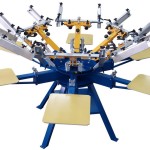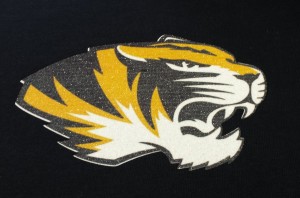For thousands of years, man has sought to enhance his image through colorful decorative clothing. Wikipedia states: “Screen printing is a form of stencilling [using a silk mesh] that first appeared in a recognizable form in China during the Song Dynasty (960–1279 AD).”
Virtually the same technology is still used today for mass-production runs of printed garments, using stencils and polyester meshes on giant octopus-shaped presses.

But surely, somewhere between silkworms, the Song Dynasty and Destiny’s Child, there’s been other methods developed for transferring ink designs to garments?
USCutter supports four alternatives for the decoration of fabrics, with each method having its upsides and limitations, and dependent on the style of ink printing you prefer.
SUBLIMATION:
Specially formulated inks, via application of heat and pressure, are chemically transferred from the printed media and infused into a polyester or polymer-coated substrate. Mugs, mousepads, and more can be decorated in photo-realistic detail. Unfortunately, these inks are not compatible with cotton or dark-colored fabrics. UNTIL NOW. Check out this video for a work-around using sublimated graphics and certain Siser heat transfer vinyl products to create bright vivid exotic textured graphics on cotton and dark colors.


HEAT TRANSFER PAPER:
You CAN print on cotton and other fabrics, dark or light, with any inkjet or laser printer. Our popular line of Joto paper products allow you to transfer printed media directly onto the surface of the garment. The whole image, including the background, is transferred; this is not a problem on light fabrics, so the image doesn’t need to be cut or weeded. However, for images to be placed on dark fabrics, contour cutting and weeding is necessary to avoid transferring the white background.
PRINTABLE HEAT TRANSFER VINYL:
For solvent, eco-solvent, or latex printers, there is a wide array of different finishes, textures, effects, and other properties like stretchability for print-and-cut materials from vinyl manufacturers such as Siser and Hexis. These products function much like standard heat transfer vinyl, but allow you to show off your high-quality inks on custom garments of all kinds.
DIRECT TO GARMENT:
What if there was a way to print directly onto a cotton or cotton-poly blend t-shirt, dark or light, with no stencil, no masking, no cutting, no reversing, no backgrounds, no size limitations, no middlemen of any kind? It seems like a no-brainer. The Epson F2000 might be the most significant contribution to garment printing history since the silkworm. All the consistency and vividness of screen printing with high-quality Epson inks and white base layer for colored fabrics puts virtual warehouses of inventory at your fingertips minus the manual labor and inflexibility of stencil production.
In this enlightened age for garments, no matter what equipment you have running in your shop, USCutter has all the supplies, ink and media options, for you to put high-quality designs on fabrics of all kinds.